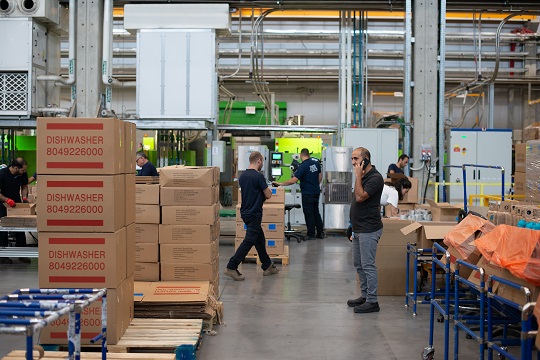Imagine you’re running a successful business - the secret sauce is effective inventory management. It’s like the backbone that keeps everything in check. What does it do? Well, it makes sure you’ve got the right stuff when you need it, avoids having too much extra stuff lying around, and makes your profits soar.
Now, in this guide, we’re going to spill the beans on the top 10 inventory management tricks. These are golden practices that any business, big or small, in any industry, should use to supercharge their operations and boost overall success.
Ready for the ride? Let’s dive in!
Before we go further into this topic, don’t forget to follow my LinkedIn account. You’ll get more helpful insights on supply chain management there.
Table of Contents
Accurate Forecasting
Alright, let’s break down the demand forecasting game. It’s like the heart of effective inventory management, making everything tick smoothly.
How does it work? Well, businesses take a deep dive into past data, market trends, and other juicy details to figure out what consumers like and want.
With this insider info, they can then predict what people will be itching to buy in the future, allowing them to plan smartly and allocate resources wisely.
Now, throw in some fancy forecasting tools and tech, and you’ve got a super-refined system that gives businesses laser-focused predictions, reducing the chances of having too much or too little stock.
This smart move helps businesses keep just the right amount of goodies in stock, matching what people actually want.
Why does this matter? Because when businesses get the forecasting game right, it’s like giving their operations a superhero upgrade. They become super-efficient and can adapt quickly to changes in demand.

Imagine this: you accurately predict when people will go crazy for your product, adjust your production plans accordingly, and make sure you never run out or have piles of stuff gathering dust.
That’s the power of nailing demand forecasting – it’s like having a crystal ball that guides businesses through the ups and downs of the market, keeping them agile and on top of their game.
Regular Audits and Cycle Counts
Alright, let’s dive into the world of inventory checks. Making sure your inventory numbers are spot-on is super important in the inventory management game.
How do you do it? Well, think of regular audits and cycle counts like health check-ups for your stock. You count the actual items on your shelves and compare it with what’s written down.
This way, if there’s any funny business going on – like items magically disappearing or appearing – you catch it early. It’s like having a superhero power that stops errors from piling up and messing with your business decisions.
Now, this auditing thing isn’t just about accuracy; it’s also like putting a big “keep out” sign for any potential thieves.
By keeping a close eye on your inventory levels and regularly checking for any weird stuff, you make it harder for anyone to sneak away with your goods.
It’s not just about protecting your stuff; it’s about making sure your inventory data is rock-solid reliable.
So, these regular check-ups aren’t just a chore – they’re like having a superhero sidekick that keeps everything in check, promoting a culture of honesty and transparency in how you handle your inventory.
Implementing ABC Analysis
Alright, let’s talk about ABC analysis – it’s like a superhero move in inventory management.
Imagine you have a bunch of products, and you want to figure out which ones are the real MVPs for your business.

So, ABC analysis puts your products into three squads. Class A is the superstar team – these are the high-value, big-money players that bring in a lot of cash. They might be a smaller group, but they’re the heavy hitters that make a massive impact on your business.
Then there’s Class B, kinda like the mid-tier squad – not as flashy as Class A, but still holding their own in terms of value.
Finally, we’ve got Class C, the lower-value crew, chipping in but not making as much noise.
Now, why does this matter? Because when you know which products are the real game-changers (Class A), you can focus your energy and resources on them. It’s like giving your star players the VIP treatment – making sure they get all the attention they need in inventory management, ordering, and getting stuff out the door. This superhero move helps you run things smoother, making your whole operation more efficient and boosting your business performance.
You might also like:
- Decoding SOP Discipline: A Close Look at How Managers Keep the Supply Chain in Check
- The Contradiction in Supply Chain Experience: Revealing Both Success and Failure
Utilizing Inventory Management Software
Let’s talk about why getting a top-notch inventory management system is like giving your business a superhero upgrade.
Imagine your business as a well-oiled machine, and this system is the secret sauce making everything run smoother. The cool thing about modern software is that it’s not your grandpa’s spreadsheet – it’s like a superhero with a bunch of superpowers.
First up, it’s got real-time tracking – that means you can see where your products are at any moment. No more waiting around, wondering where things are. And get this – it’s got automated reordering.
So, instead of scratching your head and guessing when to restock, the system does the heavy lifting. It sets limits, and when your stock is running low or going overboard, it sends out the signal to reorder.

This superhero move saves you from the hassle of manual work and keeps your products at just the right levels, avoiding situations where you run out or have too much stuff lying around.
But wait, there’s more! This superhero system doesn’t just stop at inventory – it talks to your other business systems, like sales and finance. It’s like having a bunch of friends who always share their secrets.
By linking everything together, you get this big-picture view of your business. This not only helps you make smarter decisions but also cuts down on mistakes because you’re not punching in numbers manually. It’s like having a trusty sidekick that keeps your business data on point, making sure you’re always in the loop and making smart moves based on real-time info.
Just-In-Time (JIT) Inventory System
Alright, let’s talk about the Just-In-Time (JIT) inventory system – it’s like a super-efficient way of handling goods.
So, instead of stockpiling things way ahead of time, JIT makes sure you get your goods just when you need them for production.
The idea is to keep things lean – not too much stuff lying around, which saves money on storage costs and lowers the risk of having a warehouse full of goods that might just collect dust.
By timing the arrival of materials perfectly with your production schedule, you can optimize your inventory levels, keep the cash flowing smoothly, and avoid the headache of managing a massive warehouse filled with extra stuff.
But here’s the deal – while JIT is awesome for saving costs and being efficient, it’s like a delicate dance that needs some serious planning. You can’t just jump into it; you need a solid plan and a tight partnership with your suppliers.
Creating a supply chain that’s smooth as butter is key because any hiccups in the delivery of goods can mess up your production schedule big time.

Businesses going JIT have to be like best buddies with their suppliers, working together on reliable communication, accurate predictions of what’s needed, and flexible logistics.
This teamwork ensures that your materials show up right on time, and everything runs like a well-oiled machine.
So, it’s all about balance – reaping the benefits of JIT without throwing your supply chain into chaos.
Safety Stock Management
Let’s talk about finding the sweet spot in inventory management – it’s like walking a tightrope between having just enough and being prepared for surprises.
Imagine you’re juggling between having the right amount of stuff in stock and having a safety net for unexpected twists. On one hand, you want to minimize having too much stuff lying around – it saves money and keeps the warehouse running smoothly.
But on the other hand, you need a safety net, like a cushion for those moments when the market throws you a curveball or your supply chain hits a speed bump. This safety net, called safety stock, is your backup plan to keep things rolling even when everything seems to be up in the air.
Here’s where the magic happens – the art of inventory management is about finding that perfect balance. Go too hard on minimizing stock, and you might be caught off guard by unexpected disruptions. But swing too far the other way with too much safety stock, and you’re tying up money and valuable space in your warehouse.
So, it’s like this delicate dance where you understand your industry, the market vibe, and what your customers usually want.
By fine-tuning your inventory levels – meeting the expected demand and having that safety net for surprises – you’re like a ninja in the inventory game, optimizing for both efficiency and resilience. It’s about being smart and adaptable, so your business can handle whatever comes its way.
You might also like:
- Unveiling the Hidden Costs: The Impact of Meaningless Actions on Waste in Supply Chain Management
- Supply Chain Transparency: Not About Dropping Underperforming Departments
Vendor Relationship Management
Alright, let’s break it down. Effective inventory management is like building a solid friendship with your suppliers. It’s all about open communication – sharing what you need, when you need it, and what’s happening in the market.
When you and your suppliers are like best buddies chatting openly, trust grows, and you get a sneak peek into how each other’s operations work. This teamwork makes inventory management a smooth ride.

And check this out – having reliable lead times is like having a trusty GPS. It makes sure you get your materials on time, so you can plan things just right and avoid the stress of running out of stock or production delays.
Now, let’s talk about the negotiation game. When you and your suppliers are on good terms, you can score some cool perks – like getting a good deal on prices, flexible payment plans, or even some VIP treatment during crazy demand times. It’s a win-win situation that makes your supply chain super flexible, so you can adapt like a ninja to changes in demand or unexpected bumps in the road.
This teamwork not only keeps the goods flowing but also turns your business into a smooth operator, ready to tackle anything the market throws your way.
Cross-Functional Collaboration
Alright, let’s talk about teamwork in the world of inventory management. It’s not just a warehouse thing – it’s a whole business vibe.
Imagine all the departments – sales, marketing, finance – they’re like superheroes with different powers, working together for a common goal.
The sales team, for example, knows what customers want, and that info is gold for predicting what we need to stock up on.
And the marketing folks? They’re like the architects of cool promotions that can shake up our inventory game.
When all these departments team up, it’s like creating a master plan that links inventory management to the big dreams of the business.
But here’s the secret sauce – communication is key.
Having open chat channels between teams means they’re always in the loop about what’s happening in the market, any upcoming promos, or changes in what customers are loving.
This teamwork doesn’t just make our demand predictions super accurate but also lets us change our inventory game plan fast when the business vibe shifts.
So, it’s like having a well-coordinated dance where everyone’s on the same page, making sure inventory management isn’t just a warehouse thing but a full-on business strategy that keeps everything running like a well-oiled machine.
Barcode and RFID Technology
Let’s dive into the world of high-tech wizardry that’s changing the game in inventory tracking – barcodes and RFID (Radio-Frequency Identification) tech. It’s like upgrading from a flip phone to a smartphone for your inventory game.
First up, we’ve got barcodes – those little lines you see on products. They’re like secret codes that, when scanned, instantly capture all the important data. No more manual errors or messy data entry – it’s like a speedy shortcut. Using barcodes makes managing inventory a breeze, cutting down the time it takes for tasks like stocktaking and making everything run smoother.

Now, let’s talk RFID – it’s like the superhero version of barcodes. Instead of scanning, RFID tags have these tiny chips that send out signals. It’s like magic – no need for direct scanning, and you can track a bunch of items all at once. This tech gives you a real-time view of your goods zipping through the supply chain. It’s like having superpowers for your inventory management – accurate, speedy, and giving you the upper hand in the competitive business world.
So, businesses that embrace these cool tech upgrades aren’t just reducing errors and saving time; they’re stepping into a whole new era of efficient and competitive operations.
Continuous Improvement and Adaptation
Alright, let’s talk about staying on top of the game in the ever-changing business world, especially when it comes to managing inventory.
Picture it like this: the business landscape is like a wild rollercoaster, and you need a mindset that’s all about rolling with the twists and turns. This means always looking for ways to make things better, adapting to changes, and being ready to shake things up when needed.
So, how do you do it? You gotta be like a superhero team, always on the lookout for spots where you can be even more awesome. Regularly checking how things are going, getting feedback from the crew, and learning from both the highs and lows. It’s like having a game plan that evolves as you go.
And here’s the secret sauce – keeping an eye on what’s new in the business world. Whether it’s cool trends or the latest tech tricks, being in the know helps you stay ahead of the curve.
So, businesses that embrace this mindset aren’t just managing inventory; they’re like the cool inventors of the business world, always ready to tweak and optimize things to stay on top.
Conclusion
Alright, let’s wrap it up. Becoming a pro at managing inventory isn’t just a cool skill; it’s a must-have for businesses trying to rock the fast-paced and crazy market we’re in.
Think of it like leveling up your game – adopting these top 10 inventory tricks is like having a treasure map to boost the accuracy, efficiency, and overall awesomeness of your inventory system.
With these tricks up your sleeve, it’s not just about having products ready when people want them; it’s about creating a supply chain that’s flexible, quick, and keeps customers smiling, all while stacking up those profits.
But here’s the real deal – being a master at this isn’t a one-and-done thing. It’s like a journey that needs commitment, teamwork, and a love for getting better. You’ve got to be in this constant mindset of getting smarter, learning from what works and what doesn’t, and staying in the loop about what’s hot and happening in the business world. It’s a bit like a never-ending upgrade – fixing things that aren’t working, adapting to the crazy twists in the market, and fine-tuning your inventory moves.
So, by rolling with these changes and staying on your toes, you’re not just keeping up with today’s demands – you’re setting yourself up to crush it and thrive in a world that’s always shaking things up.
I hope you find it helpful!
Please share this article with your colleagues so they can also benefit. For more insights on supply chain management, follow my LinkedIn account. You’re free to use all articles on this blog for any purpose, even for commercial use, without needing to give credit.
 by
by 

